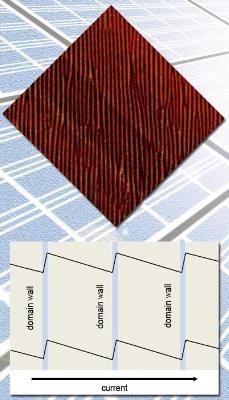Scientists at the University of California at Berkeley and the U.S. Department of Energy's Lawrence Berkeley National Laboratory (Berkeley Lab) have revealed the details of a photovoltaic process for ferroelectric materials using bismuth ferrite or BFO ultra-thin films.
The researchers have also discovered that the same principle can be applied on all types of similar materials. The BFO films investigated by the researchers have a specific periodic domain pattern spanning over distances of several micrometers. The domains create stripes, each having a width of 50 to 300 nm, isolated by domain walls of thickness of merely 2 nm. The electrical polarization in every stripe is in the opposite direction of that of its adjacent stripes.
 Domains with opposite electrical polarization, averaging about 140 nanometers wide and separated by walls 2 nanometers thick, form a well-aligned array in a thin film of bismuth ferrite. Credit: Lawrence Berkeley National Laboratory
Domains with opposite electrical polarization, averaging about 140 nanometers wide and separated by walls 2 nanometers thick, form a well-aligned array in a thin film of bismuth ferrite. Credit: Lawrence Berkeley National Laboratory
Joel Ager, one of the researchers, said that the research team accurately knew the position and the size of the built-in electric fields in BFO films. The researchers observed very high voltages, several times the material’s band gap voltage when the BFO thin films were illuminated, he said. The electrons are freed by incoming photons and form corresponding holes, resulting in the flow of current in a direction perpendicular to the domain walls, he added.
The scientists fitted platinum electrical contacts to the BFO ultra-thin films to measure the current. The experiment proved that the domain walls between the areas of opposite electrical polarization increased the photovoltaic voltage. The opposite charges on both sides of the domain wall generate an electric field that forces the charge carriers apart. At one side of the wall, electrons repel and holes are accumulated, while on the other side, holes repel and electrons are accumulated.
The efficiency of solar cells gets reduced due to the immediate recombination of holes and electrons. However, in the BFO films, the domains’ oppositely polarized charges produce strong electric fields at the domain walls to prevent the recombination. Electrons and holes move in opposite direction from the domain walls toward the domain’s center, which has a weaker electric field. As the number of electrons is more than holes, the extra electrons are forced from one domain to the other in the same direction, as directed by the overall current. Ager described it as ‘bucket brigade’ with every bucket of electrons pumped from one domain to other.
The BFO ultrathin films’ efficiency of light responsiveness is highest near the domain walls. Even though they produce ultra-high voltages, they are short of high current, another key factor for a powerful solar cell. The combination of ferroelectrics’ ‘bucket brigade’ photovoltaic effect with high currents enables fabrication of solar cell arrays with superior efficiency.
Source: http://www.lbl.gov